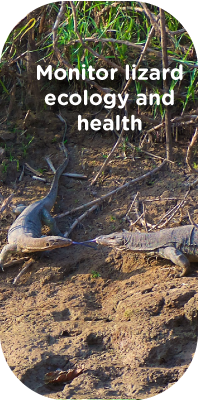PhD Candidate: Sergio Guerrero Sánchez
Institution: Cardiff University
Supervisors: Benoit Goossens, Pablo Orozco-terWengel, Pete Kille
Duration: April 2013 – April 2019
The Biawak (Malay word for monitor lizard) Project started in April 2013 as part of the DGFC action plan to know how different wildlife species adapt into a fragmented landscape within the Lower Kinabatangan Wildlife Sanctuary (LKWS). The LKWS offers an excellent landscape model to understand how different animal species adapt to commercial crops -associated fragmented landscapes and to elucidate solutions or alternatives for a sustainable land management by offering scientific information that can be used for the action plans in terms of wildlife conservation. The Asian water monitor lizard (V. salvator) is not considered in danger of extinction, yet this lizard is considered as the most hunted monitor lizard in the world because of the pet and skin trade. Indonesia and Malaysia are the biggest monitor lizard’s skin traders in the world with more than 420,000 V. salvator skins exported every year between 2005 and 2011 according with official sources. Besides of being listed as of “Least Concern” by the IUCN, this species is also listed in the Appendix II of the CITES, and in the Schedule 2 of the Sabah Wildlife Act (limited hunted under licence).
Despite the high level of extraction to satisfy the international pet and skin trade, the wild populations seem to be stable. Therefore there is a special interest in knowing how one of the biggest predators in the Southeast Asia and successful generalist has adapted to a fragmented landscape driven by the increasing oil palm crops. The abundance of the Asian water monitor lizard in the area and its tolerance and adaptability to live close to human settlements and crops is a key element that could add a special knowledge in the understanding of parasites’ transmission dynamics within an anthropogenic landscape. On the other hand, their particular characteristics as reptiles (long life, periodic skin shedding), as well as the fact that they are scavengers, are important to assess the bioaccumulation process of different pollutants derived from the different human activities but specially from the intensive use of agrochemicals in the oil palm production.
The adaptability of the species to live within wild areas and human settlements is an important issue to be assessed in this project in terms of diseases transmission between wild and human habitats; as well as in the understanding of the price that these adaptability carries to the populations in terms of health.
Research questions:
- What is the size of salvator’s home range and how does the landscape define it?
- Which factors influence the abundance and dispersion of salvator populations in the Kinabatangan floodplain landscape?
- How the population dynamics of salvator in this type of landscape influence the presence and transmission of parasites and other pathogens?
- How the habitat used by salvator influences the agrochemicals and heavy metals’ bioaccumulation inside the monitor lizard’s body?
Methods:
To understand the home-range size, habitat preferences and movements patterns we are using GPS/VHF devices (back-packs), which are deployed on the lizards over several months. Aerial photography and Geographical Information System tools will be used to analyse the data provided by the devices. All the lizards that are trapped are measured and sampled. An integral sampling procedure is performed in order to describe the general health of the populations: diet, genetics and microbiological assessment. Toxicological and molecular analyses are performed to know how the oil palm plantations’ activities around the LKWS influence in the population health of the species.
Currently, molecular sexing of individuals is taking place at the Sabah Wildlife Department’s Wildlife Health, Genetic and Forensic Laboratory
Sub-projects
In addition, the Biawak project has been used as a training project for many students and volunteers that visit DGFC. Since April 2013 until September 2015, there have been six different sub-projects as part of the requirements for internships and Undergraduate training. Beside these six students (see below), other 8 volunteers have been involved in the project, assisting and learning about the methods used. Most of the field courses that DGFC receive every year have followed the fieldwork during their stay, giving the students the opportunity to be close with such an exciting species and to learn from the Project Team (leader, students and staff). That also represents a great opportunity for the team to learn how to share their experience and knowledge with people of different backgrounds and education level.


